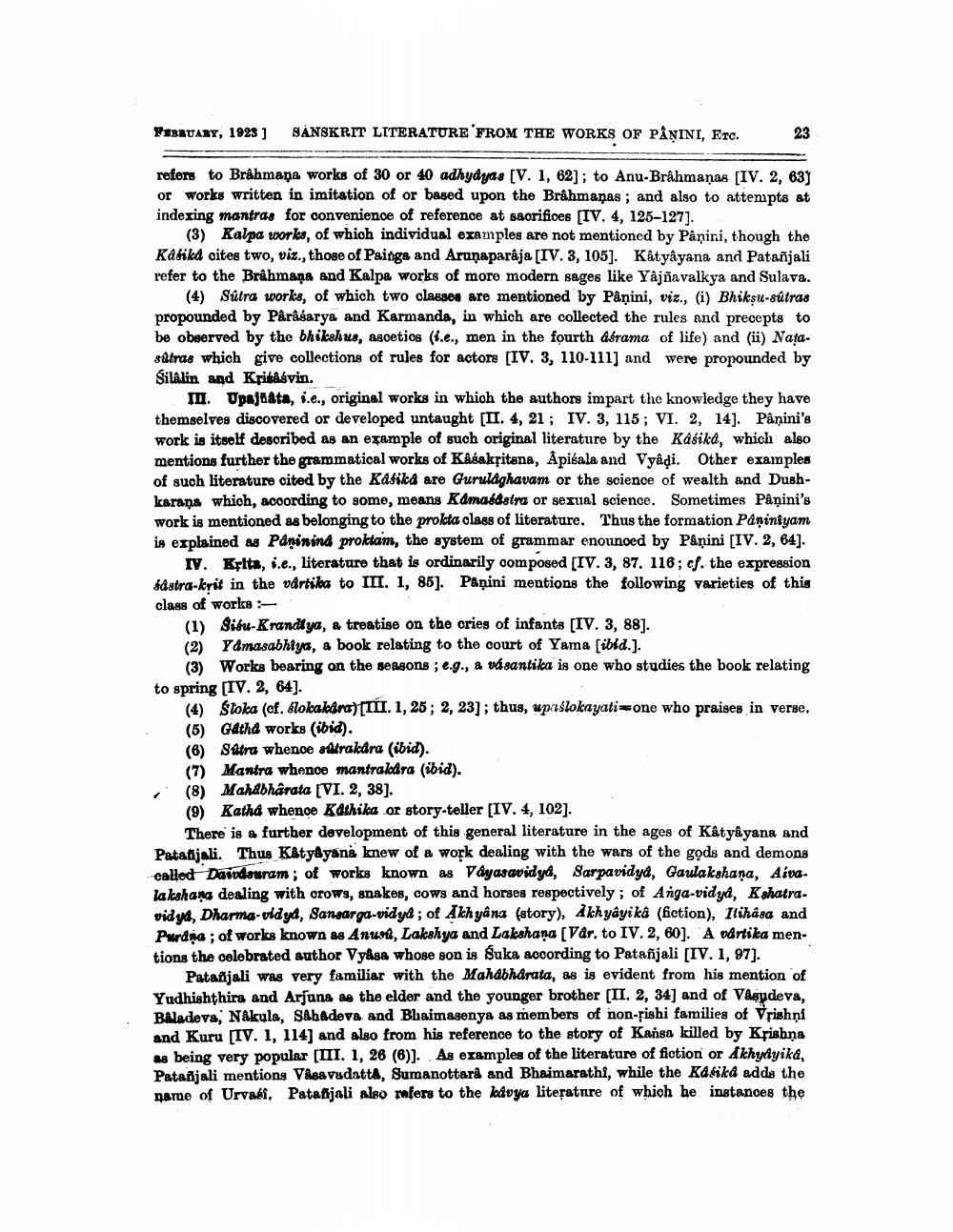________________
FEBRUARY, 1923] SANSKRIT LITERATURE FROM THE WORKS OF PANINI, ETC.
23
refers to Brahmana works of 30 or 40 adhyayas [V. 1, 62]; to Anu-Brahmanas [IV. 2, 63] or works written in imitation of or based upon the Brahmanas; and also to attempts at indexing mantras for convenience of reference at sacrifices [IV. 4, 125-127].
(3) Kalpa works, of which individual examples are not mentioned by Pânini, though the Katika cites two, viz., those of Painga and Aruņaparâja [IV. 3, 105]. Kâtyâyana and Patanjali refer to the Brahmana and Kalpa works of more modern sages like Yajnavalkya and Sulava.
(4) Sûtra works, of which two classes are mentioned by Pâṇini, viz., (i) Bhiksu-sûtras propounded by Pârâsarya and Karmanda, in which are collected the rules and precepts to be observed by the bhikshus, ascetics (.e., men in the fourth asrama of life) and (ii) Natasutras which give collections of rules for actors [IV. 3, 110-111] and were propounded by Silâlin and Krisâsvin.
III. Upajata, i.e., original works in which the authors impart the knowledge they have themselves discovered or developed untaught [II. 4, 21; IV. 3, 115; VI. 2, 14]. Pânini's work is itself described as an example of such original literature by the Kasika, which also mentions further the grammatical works of Kâsakritsna, Apisala and Vyâḍi. Other examples of such literature cited by the Kasiká are Gurulághavam or the science of wealth and Dushkarana which, according to some, means Kamasastra or sexual science. Sometimes Pânini's work is mentioned as belonging to the prokta class of literature. Thus the formation Pâniniyam is explained as Pâninina proktam, the system of grammar enounced by Pânini [IV. 2, 64]. IV. Krita, i.e., literature that is ordinarily composed [IV. 3, 87. 116; cf. the expression sastra-krit in the vârtika to III. 1, 85]. Panini mentions the following varieties of this class of works :
(1) Sisu-Krandiya, a treatise on the cries of infants [IV. 3, 88].
(2) Yamasabhiya, a book relating to the court of Yama [ibid.].
(3) Works bearing on the seasons; e.g., a vásantika is one who studies the book relating to spring [IV. 2, 64].
(4) Stoka (cf. Slokakára)[III. 1, 25; 2, 23]; thus, upalokayati one who praises in verse. (5) Gatha works (ibid).
(6) Sutra whence sûtrakara (ibid).
(7) Mantra whence mantrakára (ibid).
(8) Mahabharata [VI. 2, 38].
(9) Katha whence Kathika or story-teller [IV. 4, 102].
There is a further development of this general literature in the ages of Kâtyâyana and Patanjali. Thus Katyayana knew of a work dealing with the wars of the gods and demons called Dasudauram; of works known as Vayasavidyd, Sarpavidya, Gaulakshana, Aivalakshana dealing with crows, snakes, cows and horses respectively; of Anga-vidya, Kshatravidya, Dharma-vidya, Sansarga-vidya; of Akhyâna (story), Akhyâyika (fiction), Itihasa and Purana; of works known as Anusu, Lakshya and Lakshana [Vår. to IV. 2, 60]. A vártika mentions the celebrated author Vyasa whose son is Suka according to Patanjali [IV. 1, 97].
Patanjali was very familiar with the Mahabharata, as is evident from his mention of Yudhishthira and Arjuna as the elder and the younger brother [II. 2, 34] and of Vasudeva, Baladeva, Nakula, Sahadeva and Bhaimasenya as members of non-rishi families of Vrishni and Kuru [IV. 1, 114] and also from his reference to the story of Kansa killed by Krishna as being very popular [III. 1, 26 (6)]. As examples of the literature of fiction or Akhyayika, Patanjali mentions Vasavadatta, Sumanottara and Bhaimarathi, while the Kasika adds the name of Urvasi, Patanjali also refers to the kávya literature of which he instances the




